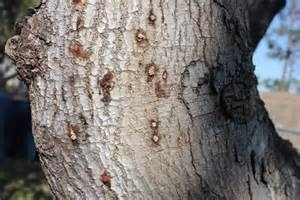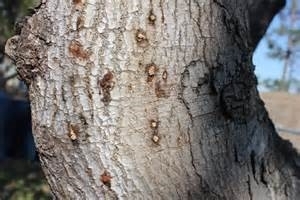
Posts Tagged: alder
Shot Hole Borer Training
Come Learn About Field Identification of Invasive Shot Hole Borers
We're holding two early December trainings on invasive polyphagous and Kuroshio shot hole borer biology, identification, surveillance, and management of infested trees and downed wood. We'll cover these topics in the classroom, then head outside to see infested trees and learn how to identify signs of shot hole borer damage, set up a monitoring program, and sample trees.
$30.00 Registration fee includes lunch, a ISHB Field Guide, and ISHB Demonstration Kit
Continuing Education Units from DPR have been requested, check back for updates.
Speakers include Sabrina Drill, UCCE Natural Resources Advisor; Bea Nobua-Behrmann, UCCE Research Scientist; Kim Corella, Forest Pest Specialist, CalFire; and Paul Rugman-Jones, Research Entomologist, UC Riverside.
Ventura County - Ojai - Dec.6
Meiners Oaks (Ojai) Class & Field Training at Saint Thomas Aquinas Church
Thursday December 6, 2018, 10am – 2:30pm
Los Angeles County - Gardena - Dec. 7th
Gardena Class & Field Training at Gardena Moneta Mason Lodge & Gardena Willows Wetland Preserve
Friday December 7, 2018, 10am – 3:00pm

field id
Host Range for Polyphagous Shot Hole Borer - Check It Out to See the Plants that are Attacked by the Fungus
http://apsjournals.apsnet.org/doi/pdfplus/10.1094/PDIS-11-12-1026-RE
But here's the abstract:
The polyphagous shot hole borer (PSHB) is an invasive ambrosia bee-tle that forms a symbiosis with a new, Fusarium sp., together causing Fusarium dieback on avocado and other host plants in California and Israel. In California, PSHB was first reported on black locust in 2003 but there were no records of fungal damage until 2012, when a Fusarium sp.was recovered from the tissues of several backyard avocado trees infested with PSHB in Los Angeles County. The aim of this study was to determine the plant host range of the beetle–fungus complex in two heavily infested botanical gardens in Los Angeles County. Of the 335 tree species observed, 207 (62%), representing 58 plant families, showed signs and symptoms consistent with attack by PSHB. The Fusarium sp. was recovered from 54% of the plant species attacked by PSHB, indicated by the presence of the Fusarium sp. at least at the site of the entry hole. Trees attacked by PSHB included 11 species of California natives, 13 agriculturally important species, and many common street trees. Survey results also revealed 19 tree species that function as reproductive hosts for PSHB., approximately a quarter of all tree individuals planted along the streets of southern California belong to a species classified as a reproductive host. These data suggest the beetle–disease complex potentially may establish in a variety of plant communities locally and worldwide.
A PSHB conference is set for February 18 at the Huntington Library in San Marino. For registration contact:
http://ucanr.edu/sites/pshb/Events/
The damage

PSHB damage
The New Borers and the Lack of Public Interest?
Without a doubt the borers, PSHB and KSHB are going to hurt avocado production, but there are some California native and landscape trees that are also going to get hammered, like unto death. Much has been written about the borers in the press, from ag journals to environmental newsletters to newspapers, such as the New York Times, Los Angeles Times and more local papers like the Ventura Star and Riverside Press-Enterprise. Recent trap findings of PSHB in Ventura county brought a local gathering of community groups to discuss the situation and the need to get more information out to local residents of the major environmental disaster at our doorstep, It seems most homeowners are not aware of the problem or if so marginally so. Is it because it's viewed as just an avocado growers' problem? The CA Avocado Commission has lead in research and spending on this problem that will affect all citizens, not just growers and consumers of the fruit. Are we all just overwhelmed by the disasters that are occurring around us here and world-wide?
I'm not sure why the lack of general interest in this issue, but the only way to get control of these pests is to stop their movement, which is largely through humans moving contaminated wood. Slowing the spread will give time to develop control methods and measures that will allow our native woodlands to cope with this infestation. There are currently people looking for pathogens and parasites in the native range of these pests, in order to determine if those native control measure would fit into a California system. But this is going to take time and in the meantime the spread needs to be slowed. Talk to your neighbors, co-workers and friends. And have them talk to their neighbors, co-workers and friends. Get the word out about what we can all do to slow the spread.
Listed below are some of the common plants in which the borer can reproduce and spread its fungi that kill the tree. Many more trees have been identified to which the borer goes, but as yet it's not known whether the fungi spread in those trees.
Known Suitable Reproductive Host Trees of PSHB:
2. Big leaf maple (Acer macrophyllum)*
3. Evergreen Maple (Acer paxii)
4. Trident maple (Acer buergerianum)
5.Japanese maple (Acer palmatum)
6. Castor bean (Ricinus communis)
7. California Sycamore (Platanus racemosa)*
8. Mexican sycamore (Platanus mexicana)
9. Red Willow (Salix laevigata)*
10. Avocado (Persea americana)
11. Mimosa (Albizia julibrissin)
12. English Oak (Quercus robur)
13. Coast live oak (Quercus agrifolia)*
14. London plane (Platanus x acerifolia)
15.Cottonwood (Populus fremontii)*
16. Black cottonwood (Populus trichocarpa)*
17. White Alder (Alnus rhambifolia)*
18.Titoki (Alectryon excelsus)
19. Engelmann Oak (Quercus engelmannii)*
20. Cork Oak (Quercus suber)
21. Valley oak (Quercus lobata)*
22. Coral tree (Erythrina corallodendon)
23. Blue palo verde (Cercidium floridum)*
24. Palo verde (Parkinsonia aculeata)
25. Moreton Bay Chestnut (Castanospermum australe)
26. Brea (Cercidium sonorae)
27. Mesquite (Prosopis articulata)*
28. Weeping willow (Salix babylonica)
29. Chinese holly (Ilex cornuta)
30. Camelia (Camellia semiserrata)
31. Acacia (Acacia spp.)
32. Liquidambar (Liquidambar styraciflua)
33. Red Flowering Gum (Eucalyptus ficifolia)
34. Japanese wisteria (Wisteria floribunda)
35. Goodding's black willow (Salix gooddingii)*
36. Tree of heaven (Alianthus altissima)
37. Kurrajong (Brachychiton populneus)
38. Black mission fig (Ficus carica)
Known Suitable Reproductive Host Trees of KSHB
1. Avocado (Persea americana)
2. California Sycamore (Platanus racemosa)*
3. Coast live oak (Quercus agrifolia)*
4. Cork oak (Quercus suber)
5. Draft coral tree (Erythrina humeana)
- Black Polar (Populus nigra)
7. Black locust (Robinia pseudoacacia)
8. Red Willow (Salix laevigata)*
- Arroyo willow (Salix lasolepis)*
- Cottonwood (Populus fremontii)*
11. Mimosa (Albizia julibrizin)
12. Castor bean (Ricinus communis)
13. Black Willow (Salix nigra)*
14. Strawberry Snowball Tree (Dombeye cacuminum)
*Native species to California
For other information sources of what these new borers can do to our wildscapes check out:
http://ucanr.edu/sites/socaloakpests/

PSHB damage
Recent finding on Polyphagous Shot Hole Borer, Fusarium Dieback – A pest-disease complex on Avocado
The Polyphagous Shot Hole Borer (PSHB), Euwallacea sp. #1, is an invasive beetle that carries three fungi: Fusarium euwallaceae, Graphium sp. , and Acremonium sp. The adult female tunnels galleries into a wide variety of host trees, where it lays its eggs and grows the fungi. The fungi cause the Fusarium Dieback (FD) disease, which interrupts the transport of water and nutrients in over 35 tree species that are suitable for beetle reproduction.
Once the beetle/fungal complex has killed the host tree, pregnant females fly in search of a new host.
A separate invasion was recently detected in commercial avocado groves and landscape trees in San Diego county. It has been determined that the damage has been caused by another closely related species of PSHB (Euwallacea sp. #2), carrying a new species of Fusarium and Graphium. The beetle in LA, Orange, Riverside, and San Bernardino Counties are morphologically indistinguishable, but genetically distinct from the beetle found in San Diego County.
Signs and Symptoms
Attack symptoms, a host tree's visible response to stress, vary among host species. Staining, sugary exudate (B), gumming, and/or frass may be noticeable before the tiny beetles (females are typically 1.8-2.5 mm long). Beneath or near these symptoms, you may also see the beetle's entry/exit holes, which are ~0.85 mm in diameter. The abdomen of the female beetle can sometimes be seen sticking out of the hole.
Sugary exudate on trunks or branches may indicate a PSHB attack (photos A-E). Note that exudate may be washed off after rain events and therefore may not always be present on a
heavily infested branch.
Hosts
PSHB attacks hundreds of tree species, but it can only successfully lay its eggs and/or grow the fungi in certain hosts. These include: Avocado, Box elder, California sycamore, Coast live oak, White alder, Japanese maple, and Red willow. Visit eskalenlab.ucr.edu for the full list.
Fusarium dieback pathogens cause brown to black discoloration in infected wood. Scraping away bark over the entry/exit hole reveals dark staining around the gallery, and cross sections of cut branches show the extent of infection. Advanced infections eventually lead to branch dieback and death of the tree
How to report a suspect tree
Please report suspected tree infestations to UC Riverside (eskalenlab@gmail.com).
Submit the following information:
•Contact information (name, city, phone number, email)
•Suspect tree species
•Description of suspect tree's location (and/or GPS coordinates)
•Description of suspect tree's symptoms
•Photos of suspect tree and close-up photos of symptoms (see examples)
Take photos of suspect trees from several distances. Include photos of:
1. the trunk or symptomatic branches;
2. the symptoms (close-up); and
3. the entry/exit hole, if visible, with a ballpoint pen for scale (remove exudate if necessary). If dieback is observed, take a picture of the entire tree.

shothole 1

shothole 2

shothole 3

shothole 4
